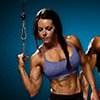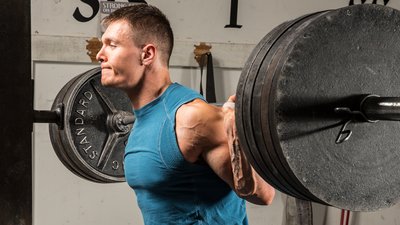Q. What Is The Best Mass Building Leg Workout?
Building thick, strong legs does not come easy. So how do guys like Branch Warren and Mustafa Mohammad build such huge, freaky legs?
What exercises should you perform for maximum leg growth?
How many sets? Reps?
What is the most effective mass building leg workout that you have tried?
Bonus Question: How does genetics play a role in building build legs?
Show off your knowledge to the world!
The Winners:
- TUnit View Profile
- RC26 View Profile
- joshrain View Profile
- stonecoldtruth View Profile
1st Place: TUnit
Building Huge Legs
Building thick, strong legs does not come easy. So how do guys like Branch Warren and Mustafa Mohammad build such huge, freaky legs? Guys like Branch and Mustafa already have incredible genes in the first place which contributes to their amazing leg growth—as do heavy training and various shocking methods.
Their workouts would often leave the average trainee dripping in a pile of sweat afterwards. Their levels of intensity have elevated them to the top in terms of leg development. On the other end of the spectrum, there are too many people who don't even train legs in the first place. Then there are those who show up to a leg workout scared of putting that 200 lb bar on their back. When you show up to a leg workout, you should think of it as an opportunity for growth of your entire body—not as a reason for being scared.
Anatomy
Before we discuss the best exercises for the legs, let's look at their anatomy.
Upper Legs
The upper leg (thigh) is comprised of the quadriceps, the hamstrings, and the glutes as the main muscle groups
Quads
The quadriceps looks like this:
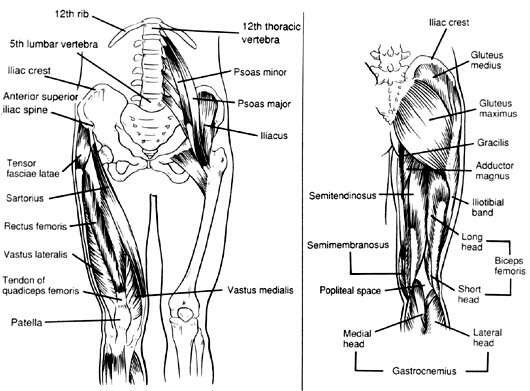
{{caption}}
The quadriceps consists of the rectus femoris, the vastus lateralis, the vastus intermedius, and the vastus medialis. The quads are responsible for extending your leg, which is also known as adduction.
The vastus medialis is the teardrop muscle that bodybuilders develop quite well. It can be trained the best with unilateral (one-legged) exercises such as split squats and lunges and it also responds very well to squatting past parallel.
Hamstrings
The hamstrings, or biceps femoris, are the muscle group that makes up the back of your thighs. The hamstrings are responsible for flexing the leg, which is also known as abduction.
The hamstrings are comprised of a long and short head, very similar to the biceps. Most exercises that hit the hamstrings, except for leg curls, will hit the glutes (Gluteus Maximus and Minimus) as well.
The hamstrings can be trained in a variety of ways—including Snatch-Grip and Stiff-Legged Deadlifts, Leg Curls, and Glute-Ham Raises. Make sure that you train your hamstrings as much as you train your quadriceps to ensure a healthy balance of leg development.
Glutes
The glutes (Gluteus Maximus and Minimus) are activated in almost all leg exercises and are one the strongest muscle groups in the body. Developing your glutes will go a long way for increases in strength.
Lower Legs
Calves
The calves make up most of the lower leg and consist of the Gastrocnemius and Soleus. Standing calf raises target the Gastrocnemius and seated calf raises target the Soleus. Another item to note is that the Gastrocnemius is primarily fast-twitch while the Soleus is primarily slow-twitch.
I personally don't train calves until late in the off-season but having a big set calves can be very impressive for a bodybuilder to say the least. If you do enough running and/or Plyometrics, however, you should be fine in terms of calf development.

{{caption}}
Q. What exercises should you perform for maximum leg growth?
For maximum leg growth, the primary exercise should be the full back squat. No other lift even comes closes to the muscle fiber activation created by squatting. Squatting also increases the amount of growth hormone the body releases.
An increase in growth hormone will not only increase leg size but you will have more full-body hypertrophy as well. Full back squats hit all the quadriceps muscles, the hamstrings, and the glutes which is why they are the king of all exercises.
However, squatting for the whole year might put too much pressure on the spine. A few spine deloading cycles should be implemented throughout the year to prevent this.
For example, unilateral exercises can be used instead. That issue aside, here are the top exercises for complete leg development:
- Full Back Squats: Total Leg and Total Body Development
- All Deadlift Variations: Total Leg Development; depending on variation, different muscle groups are trained more or less
- Regular: Quadriceps and Glutes, Hamstrings to a lesser degree
- Snatch-Grip: Hamstrings and Glutes, Quadriceps to a lesser degree
- Stiff-Legged: Hamstrings and Glutes, especially Hamstrings
- Romanian: Hamstrings and Glutes
- Glute-Ham Raises or Good-Mornings: Posterior Chain Development (Hamstrings and Glutes mainly)
- Full Front Squats with Heels Elevated: Mostly Quadriceps Development; however, hamstrings and glutes are worked to a lesser degree; elevating the heels allows the quadriceps to be hit the hardest
- Bulgarian Split Squats (Back Heel Elevated on a Bench): Total Leg Development; hits the Vastus Medialis, Hamstrings, and Glutes the hardest
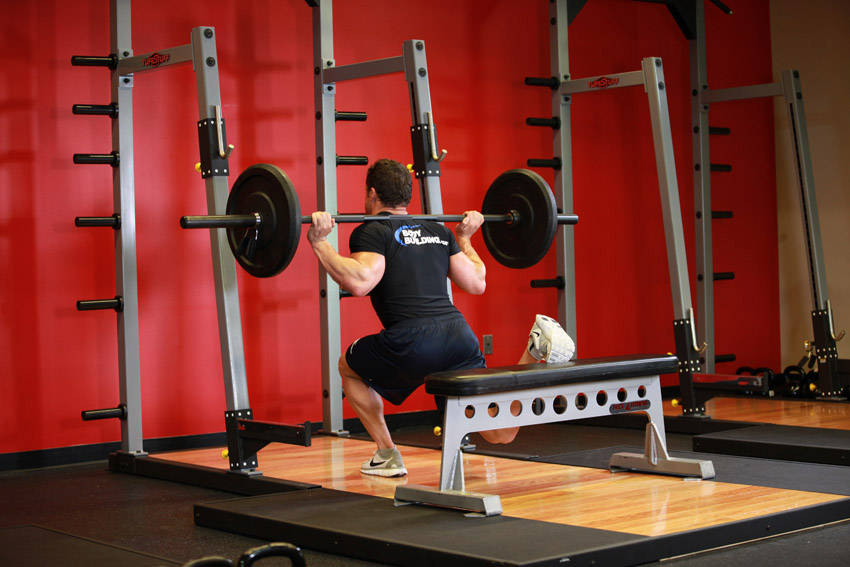
There are other exercises that isolate the quadriceps to a high degree such as Leg Extensions and Leg Presses and can be effective for Pre-Exhaust and Post-Exhaust Supersets when combined with one of the top 5 exercises.
Generally, I would not use Leg Extensions and Leg Presses because they do not maximize training efficiency. This is not to say that the two exercises are bad, but that there are much more viable alternatives.
However, if an injury prevents you from holding a bar on top of your back or from doing a front squat, then Leg Presses can be used while you recover from that injury. A general guideline for transferring squat to 45° leg press strength is Squat Weight x 1.8 / 0.707 = Leg Press Weight. For example, if you squat 500 lbs, then 500 x 1.8 = 900 / 0.707 = 1270 lbs on the 45º leg press. (0.707 is the Sin of 45°) Isolation exercises for the hamstrings are a bit different.
Leg Curls can actually be effective exercises for the hamstrings and can develop them well after a solid base has been built. As a side note, I do not think direct calf work is necessary if you Squat and Deadlift enough because calves are trained as synergists (helping muscles) in those major lifts. However, calves can be worked as parts of staggered supersets in order to ensure that they are being trained enough.
Q. How Many Sets? Reps?
When training legs, you want to use a combination of a high number of sets and low reps to build functional (sarcomeric) hypertrophy and a lower amount of sets and higher reps to build myofibrillar hypertrophy.
For the higher sets with lower reps, rest periods of 2-3 minutes would be used and for the lower sets with higher reps, rest periods of 1 minute would be used. A typical workout week could look like this (upper body would be performed Tuesday and Friday). If you want to train legs once per week, just take out Thursday and add Romanian Deadlifts to Monday's workout.
Monday: Leg Day
- Full Squats: 6-8 Sets x 3-5 Reps
- Split Squats: 3-4 Sets x 6-8 Reps
- Glute-Ham Raises: 3-4 Sets x 8-10 Reps
- Abdominal Work (Crunches, Weighted Decline Sit-Ups)
Thursday: Leg Day
- Snatch Grip Deadlifts: 6-8 Sets x 3-5 Reps
- Heels Elevated Front Squats: 3-4 Sets x 6-8 Reps
- Split Squats: 3-4 Sets x 8-10 Reps
- Abdominal Work (Side Bends, Leg Raises, Russian Twists)
With this program you would alternate the max-effort exercises (1st of each day) with one on the "Top 5" list above every 3-4 weeks. So Full Squats could be alternated with Regular Deadlifts and Snatch-Grip Deadlifts could be alternated with Good Mornings. This would help you to keep gaining while preventing plateaus or homeostasis.
Q. What is the most effective mass building leg workout that you have tried?
The most effective mass building leg workout that I have tried was one that I tried when I was a beginner. Granted, much of the gains could be attributed to me being a beginner but nonetheless it was an impressive workout.
It consisted of Full Back Squats, Split Squats, and Snatch-Grip Deadlifts. I performed it once per week and my thighs grew about 2.5 inches in two months! I didn't need to train calves because I was doing a lot of Plyometrics and sprinting at the time. This is what the workout looked like:
- Full Squats: 5 Sets x 5 Reps @ 80%
- Split Squats: 3 Sets x 6 Reps @ 75%
- Snatch Grip Deadlifts: 5 Sets x 5 Reps @ 80%
Diet
Even the most effective mass building leg workout will do nothing for leg development if your diet is not up to par. In order to grow, you must have a caloric surplus, that is, you must consume more calories than you expend.
As a general rule of thumb, eating 500 more calories than you expend will help you gain approximately 1 lb of bodyweight per week. If those calories are mostly clean, i.e. not junk food, and you lift weights regularly and lead an active lifestyle, then almost all of that weight gain will be muscle.
Protein
One of the keys to building muscle is eating at least 1 gram of protein per pound of bodyweight.
Calculate Your Protein Intake Here
Very good protein sources include:
- Chicken
- Lean steak
- Lean beef
- Pork
- Cottage cheese
- Milk
Carbs
Another key to building muscle is having a sufficient amount of carbohydrates for energy and for growth. Complex carbs such as rice, pasta, whole wheat bread, muesli, granola, and oatmeal should be ingested for maximum effect.
Healthy Fat
The often forgotten variable to a balanced diet is healthy fat. Many people eat greasy foods such as hamburgers. However, they should concentrate on eating enough flax seed oil, fish oils, and nuts such as almonds.
Supplements
Additionally, fish oil supplements can be taken so that you make sure that you are eating enough healthy fat. If you want to build muscle, a good investment would be a multivitamin to ensure that you are getting all the nutrients and vitamins you need.
Many people would be surprised how well a multivitamin can assist in muscle growth. Other valuable supplements are your basic protein powder and possibly creatine. However, supplements won't help you at all if your diet and your training are not at a high level.
Basically, if you hit a plateau, eat about 250-500 calories of healthy foods more per day and you will be amazed at what it can do for recovery and growth.
Q. How do genetics play a role in building build legs?
Genetics play a different role in each person for muscle growth, especially in the legs. Some people that I have known had huge legs from the start and when they began training they were already squatting 300 lbs or more. These people are what I would call genetic freaks.
Our body is composed of many different groups of muscles and each person has a unique composition of muscle tissue in their body. Read on here to learn more about the 3 different muscle fibers and how they build differently depending on the type of sport.
However, for everyone else, genes will not necessarily hinder muscle growth in the legs. The genes may just slow down or speed up muscle growth.
Fiber ratios may have something to do with leg development as well since fast-twitch muscle fibers have more potential for growth than slow-twitch fibers.
People with more fast-twitch fibers than slow-twitch fibers will probably be able to develop their legs faster than someone with more slow-twitch fibers.
On another note, many say that we all have a genetic limit and for the most part this is true, but it would take many years of intense training to even approach that limit. So in general, I think that fiber ratios affect leg development more so than genetic limitations.
2nd Place: RC26
Q. What Is The Best Mass Building Leg Workout?
Building thick, strong legs does not come easy. So how do guys like Branch Warren and Mustafa Mohammad build such huge, freaky legs?
Legs are the largest and strongest muscles of the body. Bodybuilders like Branch Warren and Mustafa Mohammad build their legs by training hard and eating right. It takes many years to develop legs like those bodybuilders you see in the magazines. To look like a bodybuilder, you have to train like a bodybuilder.
Leg training is very painful, but over time all that pain will give you well developed legs. Legs were created to walk hundreds of miles. Running and jumping also involve the legs.
Legs are used so much in our daily lives, so why do a lot of people neglect leg training? It's quite simple, they're either not dedicated enough or can't deal with the pain of leg training. To build mass in your legs, you have to lift heavy weights, but make sure you use correct form. The better your form, the more results you'll get, and you'll prevent injuries from happening.
Q. What exercises should you perform for maximum leg growth?
There are many muscles in the legs, and most people don't know them. You should at least know the major muscles along with their functions, so here they are:
Tensor Fasciae Latae
This upper thigh muscle braces the knee when walking.
Sartorius
This front thigh muscle brings the leg into a cross-legged sitting position. It's the longest muscle in the body.
Quadriceps
These muscles are located at the front of the thigh. Their function is to extend and straighten the leg.
- Rectus Femoris
- Vastus Medialis
- Vastus Lateralis
- Vastus Intermedius
Glutes
These muscles are located in the buttocks region. They allow you to rise from a sitting position, climb and run rather than walk, and go upstairs.
- Gluteus Maximus
- Gluteus Medius
- Gluteus Minimus
Hamstrings
These muscles are located at the back of the thigh. Their function is to curl the leg back.
Biceps Femoris (Long Head—Ischial Tuberosity, Short Head—Linea Aspera)
- Semitendinosus
- Semimembranosus
Calves
The muscles in the lower leg. Their functions are to flex the foot.
Gastrocnemius (Medial Head—Medial Epicondyle of Femur, Lateral Head—Lateral Epicondyle of Femur):
- Soleus
- Tibialis Anterior
Injury
Lifting heavy weights can easily lead to injuries. Here are common injuries that could happen if bad form is used when exercising:
Disc Herniation
This is a very common injury in weightlifting, usually caused by incorrect back position during the squat or deadlift. When performing one of these exercises, never round the back.
To prevent disc Herniation, whenever heavy weights are used, it is essential to create a block. The block involves three actions which keep you from rounding your back.
What you do is expand your chest and hold a deep breath to fill the lungs to prevent the chest from collapsing forward, contract the abdominal muscles to support the core which prevents the torso from collapsing forward, and arching the lower beck by contracting the lumbar muscles to position the spinal column in extension.
Knee Instability
This injury is usually occurs when performing asymmetrical exercises such as the lunge. To prevent this injury, whenever you perform the lunge, make sure you control the speed and the form of the movement to protect the knee.
Exercises
Squats
There are many exercises for the legs, but the first that comes in mind is the squat. The squat is compound movement which involves the muscles in the upper thigh, the abdominals, and the lower back.
When performed with correct form, this exercise builds mass and strength in the thighs. Heavy squats with correct form are the best mass building exercise for the legs. There are many variations for the squat, and here is a list of them:
- Squats
- Heavy Squats
- Full Squats
- Half Squats
- Machine Squats
- Front Squats
- Hack Squats
- Power Squats
- Dumbbell Squats
- Overhead Squats
- Sissy Squats
Leg Presses
Besides squats, leg presses will help gain a lot of mass in your legs.
Deadlifts
Deadlifts will also help you develop leg mass. Deadlifts shouldn't be included in your leg day, but make sure you include them on your back days.
The only kind of deadlift that should be done on leg days is the straight leg deadlift.
I didn't include leg extensions in the program, because they won't help you develop mass, they only develop definition.
Since legs are very big muscles, they have to be trained with more exercises and more sets. You can't get big upper legs by just performing two or three exercises per workout.
Lower Legs
On the other hand, three to four exercises should be enough for lower legs, because calves are a much smaller muscle group compared to the quadriceps and the hamstrings.
Some people believe that one exercise per workout is enough for calves, but calves have to be treated like any other body part, especially if you want them to get big. Calves should be about the size of your arms.
Another mistake a lot of people do is they don't train the tibialis anterior. Training this part of the lower leg can make it bigger.
Calves should also be trained outside of the gym. Running for 15-30 minutes, sprinting 100 meters, performing box jumps, and performing plyometrics will help your calf development.
Keep in mind that one of the unique things about legs is that they have a lot of muscular endurance. This is especially true when it comes to calves, so I included a running/plyometrics day in the program.
Training Split
Legs should be trained two times a week. Before each workout I included a warm up, and on upper leg days, after the warm up, I included stretching at the beginning and at the end of the workout.
You always have to warm up before you stretch. Stretching allows you to train harder and more safely. Stretching also increases your flexibility which can help you get a longer range of motion when exercising. That will give you the ability to contract additional muscle fiber, leading to the best muscle gains possible.
Monday and Thursday: Lower Legs
- Jump Rope: Jump rope for 10 minutes to get your heart rate up and get your calves warmed up.
- Standing calf raises (gastrocnemius): 5 sets of 15, 6, 6, 4, 4 reps
- Donkey calf raises (gastrocnemius): 5 sets of 15, 6, 6, 4, 4 reps
- Seated calf raises (soleus): 5 sets of 15, 6, 6, 4, 4 reps
- Reverse calf raises (tibialis anterior):** 5 sets of 15 reps
Tuesday and Friday: Upper Legs
Ride The Bike: Jump on the exercise bike for 10 minutes to get your heart rate up and get your legs ready for what they're about to go through.
Stretch: Stretch for 5 minutes.
Quadriceps Stretches: to stretch the front of the thighs.
Hamstring Stretches: to stretch the hamstrings and lower back.
Inner Thigh Stretches: to stretch the inner thighs.
Forward Bends: to stretch the hamstrings and lower back.
Lunges: to stretch the inner thighs, hamstrings, and glutes.
Heavy squats (quadriceps, hamstrings): 5 sets of 15, 6, 6, 4, 4 reps
Leg presses (quadriceps, hamstrings): 5 sets of 15, 6, 6, 4, 4 reps
Superset:
- Squats (quadriceps): 5 sets of 15, 6, 6, 4, 4 reps
- Standing leg curls (hamstrings): 5 sets of 15, 6, 6, 4, 4 reps
Superset:
- Standing leg curls (quadriceps): 5 sets of 15, 6, 6, 4, 4 reps
- Lying leg curls (hamstrings): 5 sets of 15, 6, 6, 4, 4 reps
Stretch: Stretch for 5 minutes.
- Quadriceps Stretches: to stretch the front of the thighs.
- Hamstring Stretches: to stretch the hamstrings and lower back.
- Hurdler's Stretches: to stretch the hamstrings and inner thighs.
- Feet Apart Seated Forward Bends: to stretch the hamstrings and lower back.
- Lunges: to stretch the inner thighs, hamstrings, and glutes.
Saturday: Running/Plyometrics/Lower Legs:
- Run for 15-30 minutes or Sprint 100 meters five times, perform box jumps for 5-10 minutes or Perform plyometrics for 15-30 minutes
*There is no warm up set for reverse calf raises
Q. How Many Sets? Reps?
This program includes a lot of sets, up to 5 for certain exercises, but reps are very low, usually in the 4-6 rep range. The reason for this is that heavy weights are being used and that's what creates mass.
Make sure your rest periods between sets are about 1 to 2 minutes. Not only will that keep your pump, but your level of intensity won't drop. The higher your intensity level, the better.
Q. What is the most effective mass building leg workout that you have tried?
The most effective mass building leg workout that I've tried is very similar to the one posted above. I trained legs twice a week, and I still do today.
One of the things I've learned is that when you do the same workout for a long period of time, you eventually hit a plateau, and your muscles stop growing. Muscles adapt to the same training, so what you have to do is change your workout every couple of weeks or months.
I also try to include as many shocking techniques as possible including forced reps, partial reps, supersets, the instinctive principle, and the isotension principle. I believe that between sets, instead of just standing around doing nothing, flex and contract your muscles.
This is called the isotension principle. Doing this keep your muscles pumped and will make your muscles look that much better. A big mistake that I made in the past was I was overtraining.
My workouts were over 3 hours long, and that is completely unnecessary. I learned that training for one to two hours is more than enough. What overtraining does is slow down your muscular gains and put you in the risk of injury.
Remember that actual growth takes place when you rest, not when you're in the gym training. That's why you have to include rest days, and get plenty of sleep.
Along with working out, eating is very important, especially if you want to gain a lot of mass. Here are some of the nutrients that you'll need:
- Protein: Composed of many amino acids, protein is used by the body to build, repair, and maintain tissue, and is involved in the structure of skin, bones, and tendons.
- Carbohydrates: composed of many sugar and starch molecules, carbs are the body's primary source of energy.
- Fats: made up of carbon, hydrogen, and oxygen, fats provide energy.
- Water: transports various chemicals in our body, which is made up of about 50% water.
- Vitamins: organic substances that help trigger reactions in the body.
- Minerals: inorganic substances that contribute in a variety of metabolic processes.
Depletion in any of these nutrients can hold back your progress. I think that a good diet for mass is divided like this: 35% protein, 40% carbs, and 25% fat.
If you can't get enough vitamins and minerals in your diet, then buy a vitamin and mineral supplement. Once a week have a cheat day, but keep it to a minimum.
I usually eat every 2 to 3 hours, and about 5 to 6 meals a day. Here is a sample diet:
- Meal 1: protein shake, a banana
- Meal 2: a couple of chicken breasts, 5 whole eggs, water
- Meal 3: 6 ounces of steak, chicken caesar salad, water
- Meal 4: protein shake, an apple
- Meal 5: a couple pieces of fish, half-cup steamed broccoli, water
- Meal 6: protein shake, a banana
Q. How does genetics play a role in building build legs?
Genetics play a huge role in building legs. Some people are born with massive legs, others have to train for years just to see a slight difference. But most people can overcome their genetics and reach their goal by training hard and training smart. Most bodybuilders started out as skinny people, but over the years they grew, and ended up with big muscles. You can't get big overnight, no matter what you do.
It is said that most people use only 30% of their brains, well most people only use 30% of there muscles. Don't be one of those people, keep training until you see results, and the rest will be history.
3rd Place: joshrain
Legs are often the most neglected part of the modern day bodybuilder. The reason is, most people view the legs as something that is not important to train, they think that all work should be focused on only upper body.
I have witnessed this sort of attitude first hand. I have trained with people who had great potential of entering, and possibly placing in a bodybuilding competition.
The reason these people could not enter, was because they fully understood that they had a lagging lower body, and the resaon for their shortcoming was simply, that they did not train these muscles.
I personally think this is ludacris, because I understand the importance of lower body training, the legs have a variety of useful functions, not just in the realm of bodybuilding, but also in sports such as boxing, baseball, soccer, and many more.
Simply put, leg training is something that should never be neglected, as it has so many useful functions that span from bodybuilding, to sports, to simply performing every day functions such as walking and running.
Q. Building thick strong legs does not come easy So how do guys like Branch Warren and Mustafa Mohammad build such huge, freaky legs?
Have you ever looked at a professional bodybuilder, and thought to yourself, how do these guys get such massive and freaky legs? Well there is a variety of variables to factor into the equation, one of the variables is genetics, these guys were most likely born mesomorphs or endomorphs, making it easier for them to gain mass when compared to an ectomorph.
The pros also are very strict when it comes to dieting and proper excercise form and program. but most important of all, these guys have something that alot of people don't, they have the right attitude.
They have that same sort of determination, and perserverance that Rocky Balboa had, and this is what drives them forward, and gives them the will to succeed.
So when concluding this portion of my article, I must state that if you want to build some quality mass on you legs, than you must have one factor that triumphs amongst the rest... You must have the will to succeed!
Q. What exercises should you perform for maximum leg growth?
Before I start reccomending some exercises for you, I want to break down some basic Leg anatomy for you, so that you can understand how the legs work, and what exercises are working which part of your legs.
As you may notice, I have compared the leg muscles functions to our arm muscles functions, so that it is easier for you to understand.
Quadriceps
The quadriceps are the muscles at the front of the thigh which act as extensors of the leg. The basic function of the Quads is to extend and straighten the leg.
The Quadriceps have a similar function to the tricep muslces in our arms.
Hamstrings
The biceps femoris (hamstrings) are the thigh flexors at the rear of the leg. The basic funtion is to curl the leg back
The Hamstrings have a similar function to the bicep muscles in our arms.
Calves
The calves has three main muscles. The soleus, which is the muscle at the side of the calf. The gastrocnemius, which has two heads, located at the back of the calf, and the tibialis anterior, which runs up the front of the lower leg anlong side the shin bone. all of these muscles share the same basic funtion, which is to move our feet.
The Calves have similar function to the forearm muscles in our arms.
The Exercises
Before I get to the meat and potatoes of this section, I want to show the results of EMG studies that show which exercises produce the greatest amount of stimulation within each target muscle group. You can now see which exercise will benefit your leg muscles the most, by using this chart.
Muscle Stimulation
Quadriceps:
- Squats (parallel depth, shoulder-width stance): 88% EMG muscle stimulation
- Seated leg extensions (toes straight): 86% EMG muscle stimulation
- Hack Squats (90 degree angle, shoulder-width stance): 78% EMG muscle stimulation
- Leg press (110 degree angle): 76% EMG muscle stimulation
- Smith machine squats (90 degree angle, shoulder-width stance): 60% EMG muscle stimulation
Hamstrings:
- Standing leg curls: 79% EMG muscle stimulation
- Lying leg curls: 70% EMG muscle stimulation
- Stiff Legged Deadlifts: 63% EMG muscle stimulation
Calves:
- Donkey calf raises: 80% EMG muscle stimulation
- Standing one-leg calf raises: 79% EMG muscle stimulation
- Standing two-leg calf raises: 68% EMG muscle stimulation
- Seated calf raises: 61% EMG muscle stimulation
Yes, finally we're getting to the fun section. In my opinion, and the opinion of countless others, these are the best exercises for building quality mass on those legs.
Please remember though, if you want these exercises to work properly, than you must follow and perfect the correct form. Without correct form , these exercises will not benefit you to your full potential, and you will increase the possibilty of injury, so i can not stress this enough--Use Perfect Form!
Before you jump into the exercising, remember to first do a complete stretching routine, focusing on a good quadricep stretch, hamstring stretch and claves stretch. Once your muscle are loosend up, you can start lifting.
Squats
These are the granddaddy of all exercises, it targets every part of your leg, (quads,hams,calves,glutes) and also works some other muscles on a minor note such as abdominals.
The squat is also a heavy movement, so when doing squats, it will release growth hormones (GH) and allow you to build even more mass, than you were before. The purpose of the squat is to build mass and strenghth in the legs, especially the thighs.
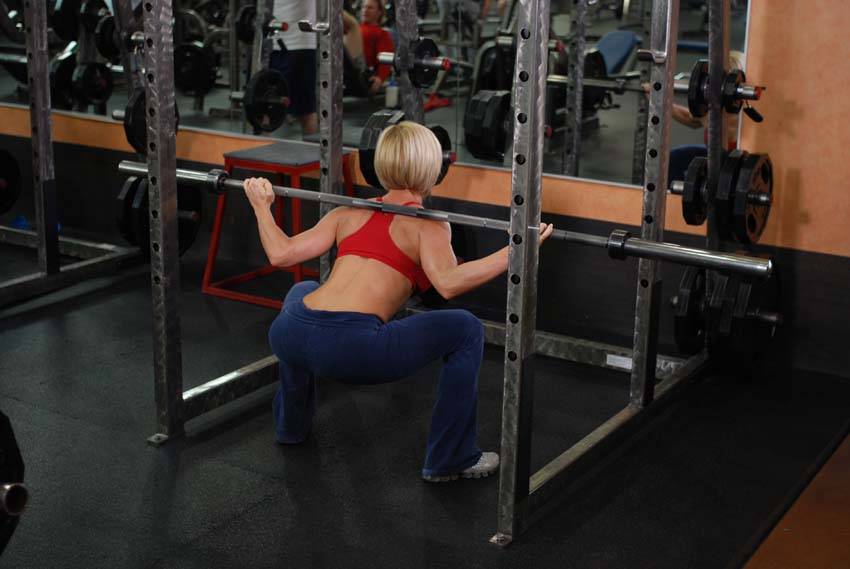
Full squats are one of the traditional mass-building exercises for the entire lower body, but are primarily used for developing all four heads of the quadriceps. There is also many different squats variations (half,machine,front,sissy,hack) so try some of them, and pick one that meets your specific needs.
If you are not including squats in your current program, then by all means add it now, I promise it will benefit you.
Leg Extensions
The purpose of this exercise is to define and shape the front of the thigh. Leg extensions are great for getting really deep definition in the quadriceps without losing any size, and especially great for developing the area around the knees.
I reccomend this exercise to be used along side any other heavy leg movements, this way you get mass and definiton all at once.
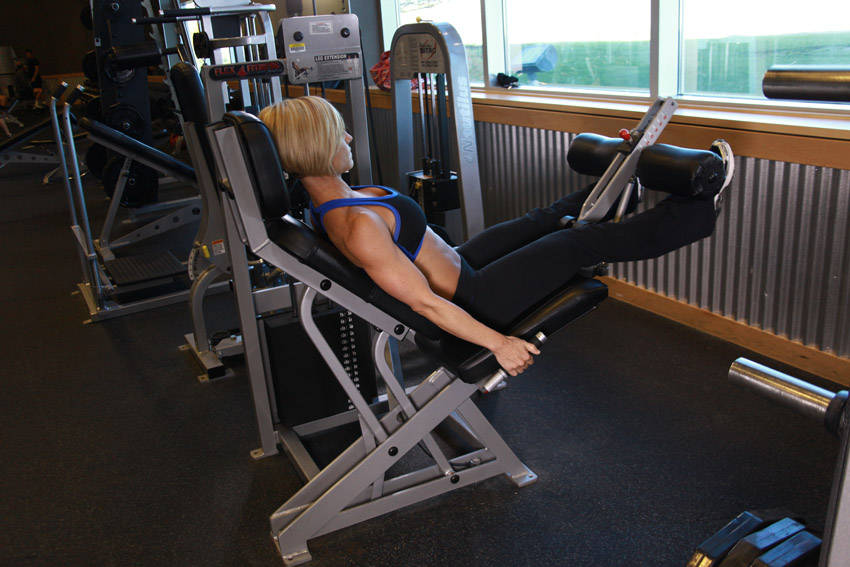
You can also do these one leg at a time to target one specific leg at at a time, in case you want to have perfectly proportioned definiton in your legs.
Standing Leg Curls
The purpose of this exercise is to develop your hamstrings (rear of your thigh). I believe that you get the most benefit out of the standing leg curl becuase it allows you to isolate you r hamstrings more, and you can get the furthest range of motion.
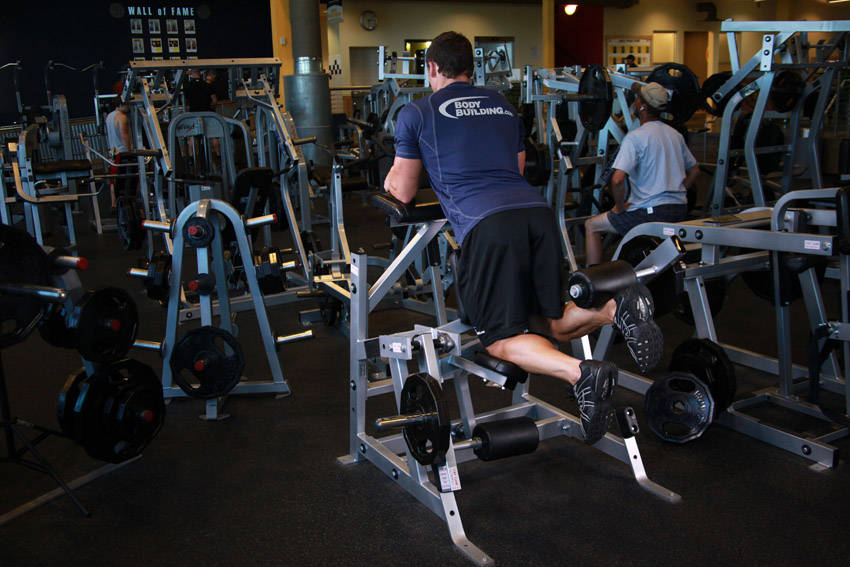
You can also do these alternating legs to target one specific leg at at a time, in case you want to have perfectly proportioned hamstrings in your legs.
Stiff Leg Deadlifts
The purpose of this exercise is to develop your hamstrings and glutes. The deadlift also develops your lower back. Please be sure to use correct form, don't round your back when doing these, stay perfectly straight. If you are doing these correctly, you should feel a stretch in your hamstrings.
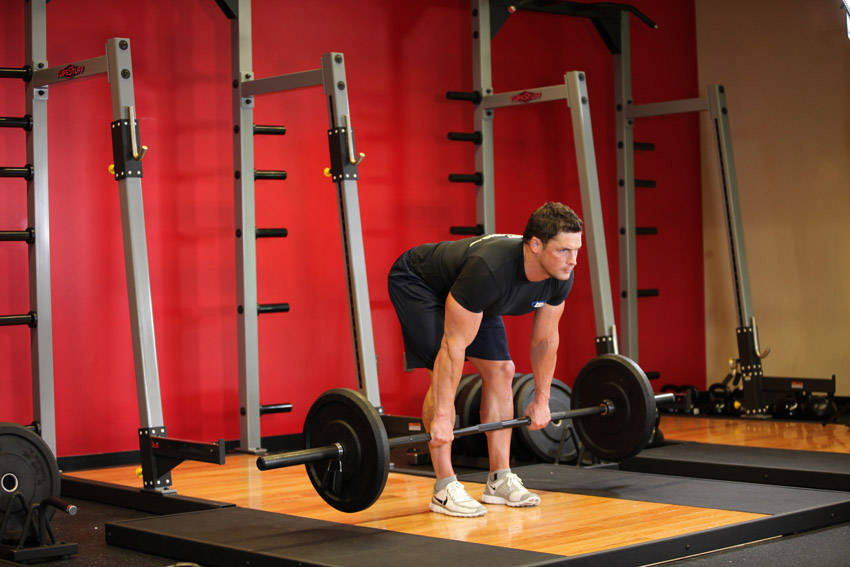
Donkey Calf Raises
The purpose of this exercise is to develop the thickness of the back of the calves. These can really make your calves look huge when viewed from the side.
Standing-One-Leg Calf Raises
The purpose of this exercise is to isolate each set of calf muscles. Doing calf raises one leg at a time is essential when one calf is larger than the other and you need to make the proportional.
Reverse Calf Raises
The purpose of this exercise is to develop the front of the lower leg. Many bodybuilders forget about developing the muscles at the front of the calves, primarily the tibialis anterior, which seperates the indide calf from the outside calf and makes the leg seem much larger.
Q. How Many Sets? Reps?
Since this topic is based soley around gaining some quality leg mass, you are going to want to stay in the low reps range, and the heavy weight area. for sets I reccommend doing 4 sets for each primary exercise and 3 sets for each secondary exercise.
You have to keep in mind that everyones body is different, so what might be right for me, may not be right for you. I am reccomending that you play around with the reps ans sets, so that you can make this program fit your specific needs.
Here is a basic reps/sets template:
- Squats: 8-10 reps / 4 sets
- Leg Extensions: 8-10 reps / 3 sets
- Standind Leg Curls: 8-10 reps / 4 sets
- Stiff Leg Deadlifts: 8-10 reps / 3 sets
- Donkey Calf Raises: 8-10 reps / 4 sets
- Standing One Leg Calf Raises: 8-10 reps / 3 sets
- Reverse Calf Raises: 8-10 reps / 3 sets
I believe that changing your rest time between sets, has a great effect on your body. what this does is, say one week you rest 2 minutes, and the next week 1 minute.
On the first week your body will get used to the constant rest period of 2 minutes, but once you immediately switch it on the second week, your body will be thrown off guard, and shocked at the sudden change, and it will be forced to make larger muscle gains. So this resting program i have designed will allow you to use this sort of shock therapy.
- Week 1: rest 2:00
- Week 2: rest 1:30
- Week 3: rest 1:00
- Week 4: rest 0:30
After week 4, increase the weight and restart again at 2 minutes, and move down the list again.
Q. What is the most effective mass building leg workout that you have tried?
I have tried many different leg programs in my life, but it seems that only one has had the potential to work wonders for me. Be aware that I was born an ecto/mesomorph body type, so for me to gain a sufficient amount of muscle, I had to work hard, contributing massive amounts energy and time into my workouts, and if you truly want to be all that you can be than you must contribute just as much as I have.
As you can see below, I have made a template for an all around leg development program, and gave suggestions for training the weak parts of your legs.
In the 4 week program below, I have made it so that you gradually lower your repetitions, and increase your number of sets each week. I expect that when doing this, you are increasing the amount of weight to balance all of this out.
Week 1
- Squats: 10-12 reps / 3 sets
- Leg Extensions: 10-12 reps / 2 sets
- Standind Leg Curls: 10-12 reps / 3 sets
- Stiff Leg Deadlifts: 10-12 reps / 2 sets
- Donkey Calf Raises: 10-12 reps / 3 sets
- Standing One Leg Calf Raises: 10-12 reps / 2 sets
- Reverse Calf Raises: 10-12 reps / 2 sets
Week 2
- Squats: 8-10 reps / 3 sets
- Leg Extensions: 8-10 reps / 3 sets
- Standind Leg Curls: 8-10 reps / 3 sets
- Stiff Leg Deadlifts: 8-10 reps / 3 sets
- Donkey Calf Raises: 8-10 reps / 3 sets
- Standing One Leg Calf Raises: 8-10 reps / 3 sets
- Reverse Calf Raises: 8-10 reps / 3 sets
Week 3
- Squats: 8-10 reps / 4 sets
- Leg Extensions: 8-10 reps / 3 sets
- Standind Leg Curls: 8-10 reps / 4 sets
- Stiff Leg Deadlifts: 8-10 reps / 3 sets
- Donkey Calf Raises: 8-10 reps / 4 sets
- Standing One Leg Calf Raises: 8-10 reps / 3 sets
- Reverse Calf Raises: 8-10 reps / 3 sets
Week 4
- Squats: 6-8 reps / 4 sets
- Leg Extensions: 6-8 reps / 3 sets
- Standind Leg Curls: 6-8 reps / 4 sets
- Stiff Leg Deadlifts: 6-8 reps / 3 sets
- Donkey Calf Raises: 6-8 reps / 4 sets
- Standing One Leg Calf Raises: 6-8 reps / 3 sets
- Reverse Calf Raises: 6-8 reps / 3 sets
Once you have completed the 4 week program, I suggest staying in the 6-8 rep range, but still continue to increase the amount of weight you are doing.
You should also use the resting time program that is listed above.
Weak Point Training
These are the exercises you should focus on, if one part of your legs is lagging. So if you are weak in any of these leg muscles, than by all means, incorporate them into your leg program.
- Lower thigh development: squats, hack squats, leg press, leg extensions
- Outer thigh development: front squats, hack squats, leg press (feet together and pointed straight)
- Inner thigh development: barbell lunges, stiff leg deadlifts, leg press (feet wide stance and turned outward)
- Inside of calves: calf raises (feet turned outward)
- Outside of calves: calf raises (feet tuned inward)
Q. How does genetics play a role in building big legs?
It is true that genetics do play a big role in how we develop our legs. Some people are just born with naturally large legs, so it comes easy for them to have the perfect lower body.
But don't back out now just because you don't have great genetics, there is still a chance for you to get the legs that you desire. You will have to work like a dog to get to that point where you are satisfied with your body.
I understand personally how much people with good genetics can anger us "average" people, but you have to take this type of anger and use it constuctively, when you are lifting weights, lift harder, lift with more intensity with the goal in mind of surpassing these people, and you will be the one who is truly satisfied with your body.
3rd Place: stonecoldtruth
Have you ever noticed that the base of an object is typically it's strongest point? Take the pyramids for example; their very foundation has allowed them to hold up to the test of time.
Will your foundation stand up to the test of time? Today we will discuss the topic of building your scrawny chicken-little legs into massive tree trunks.
Pros:
Q
Building thick, strong legs does not come easy. So how do guys like Branch Warren and Mustafa Mohammad build such huge, freaky legs?
The pros use some crazy methods to obtain their godlike physiques, but none so much as Branch Warren. Recently in a bodybuilding publication Branch recounted his most brutal workout.
Let's just say that leg extensions at sets of 100 are a bit beyond my imagination, and drop sets of 25 on leg press... INSANE! The pros get their huge, freaky legs by completing workouts that make us normal mortals queasy at the mere thought.
Q. What exercises should you perform for maximum leg growth?
Before we begin with what exercises to do, I'd like to offer a basic breakdown of the major muscles of the legs. Now I'm not talking about going all medical on you, but instead we will stick to the basics.
Quadriceps
The muscle group lying at the front of your thigh. The main action of the muscle is to straighten your leg.
Hamstrings
The muscle group lying at the rear of the thigh. The main action of the muscle is to curl the lower leg relative to the upper leg.
Glutes
While technically a seperate muscle group. The glutes (which are suprisingly one of the largest and strongest muscles in the body) are recruited in MANY leg exercises.
Calves
This is by far my favorite part of the lower body. Interesting fact, did you know the meaning behind Calves is derived from the Greek, gastroknemia, "the belly of the leg".
Ok, I might get a bit technical here. The calves are broken down into the Gastrocnemius & Soleus. The Gastrocnemius is the more visible of the two, and what most people think of when they are talking about calves.
The Soleus runs from just below the knee all the way down to the ankle. The function of the Calves are many, from walking to dancing, standing to jumping, and countless others. A fun fact though, if it were not for the soleus muscle's constant pull you would not be able to stand up, but would fall forward.
OK! On To The Exercises
Squat
As with any major muscle group it is going to be important to ensure you hit your compound movements hard and heavy. Saying this, the cornerstone of any leg growth routine will be squats.
There are variations on the traditional free-weight squat, but for now we will just focus on a basic squat. Squats focus on the quads, glutes, hamstrings, and lower back. However, squats also work your abs and pretty much the rest of your body.
Lunges
Second to the squat, but still vital to building those massive tree trunk legs, are lunges. You know those cute girls you see doing walking lunges with 10lb Dumbbells in the gym? Well that is like the preschool version of our lunges.
Our version involves a barbell with 45s, not 10lb Dumbbells. Barbell squats will, like the Squat, hit the quads, glutes, and hamstrings while using the rest of your body for stabilization.
Hamstring Curl
Now that we are already exhausted and sweating buckets, now we head over to do some isolation. Our first isolation exercise is going to be the Hamstring Curl.
Many gyms have standing, seated, and lying leg curls. For our example we will use the Lying Hamstring Curl, since it is my favorite of the three. On this exercise we are going to make use of the fuse format.
The negative portion of your reps should be taking about a full 10 seconds; we liken this to a burning fuse for a bomb, and then when you reach the bottom of your rep EXPLODE UP, umm like a bomb. Using this isolation exercise combined with the fuse format you can quickly fry your hamstrings. Now we crawl over to the next isolation exercise.
Leg Extension
Once you've managed to pull yourself off the floor we are going to head over to do some Leg Extensions. Some may argue that this movement is not the most effective of the quadriceps exercises, and I would agree.
That is why we already went hard and heavy on both our squats and lunges before coming here. Leg Extensions are just the finishing move for your quads.
The key to Leg Extensions is to NEVER let the tension leave your quads. On the negative motion many people set the starting point too low/far back to where the tension leaves the quads, this is the last thing we want. Here we aim for a longer time under heavy tension.
Calves
The last and often most under-trained muscle in our legs are our calves. I personally think calves can be hit on any workout day, not just leg day. Almost all calf exercises revolve around 'raising' and this will be no different.
For calves I actually like to mix it up. I see a major benefit from seated calf raises, as it takes out any stabilization muscles and forces you to rely solely on your calves.
In addition, the donkey calf raise seems to be very effective if your goals are mainly size. So for our purposes we will use both the seated and donkey calf raises. It should be noted that seated calf raises work exclusively the soleus muscle (see the science lesson earlier paid off).
If you use proper form on these and aren't afraid to go hard and heavy then you WILL size definite size gains on your leg routine.
Q. How Many Sets? Reps?
I personally am a fan of finding the balance between overload and time under tensions. For this reason I've made the "rep quandary" as simple as can be:
- Squats: 6 to 8 reps, 3 working sets
- Barbell Lunges: 6 to 8 reps, 3 working sets
- Hamstring Curls: 10 to 12 reps, 3 working sets
- Leg Extensions: 8 to 10 reps, 3 working sets
- Seated Calf Raises: 6 reps, 2 working sets
- Donkey Calf Raises: 6 reps, 2 working sets
You may notice that the Leg Extension reps are lower than the Hamstring Curls. This is due to my belief that lunges are SO effective that less is needed to destroy the quads.
Also, the calf sets involve low reps. Here we apply a straight OVERLOAD philosophy. In other words, go heavy or go home.
Q. What is the most effective mass building leg workout that you have tried?
Before I found Barbell Lunges I used the following leg workouts for mass purposes:
- Squats: 3 sets of 4-6
- Stiff Legged Deadlift: 3 sets of 6-8
- Hamstring Curls: 3 sets of 8-10
- Leg Extensions: 3 sets of 10-12
- Seated Calf Raises: 4 sets of 12-15
Notice the progressive rep cycle there, it was similar to an inter-set pyramid structure.
Q. How does genetics play a role in building big legs?
Genetics seem to a win, lose, or draw type of thing when it comes to building some massive trunks, or just bodybuilding in general. Some people have massive legs without ever doing any mass training on them, and it is ok to hate those people.
For the rest of us, we can overcome our genetics. I personally wouldn't want to have those kinds of 'it comes natural' genetics; I want to earn my muscle.
Josh Graston aka Stonecoldtruth
